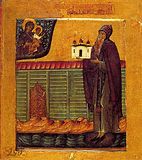

| Previous day | Next day |
| Old Style
August 3
|
Monday |
New Style
August 16
|
|
9th Week after Pentecost.
Tone 7.
Успенский пост. |
Monastic rule: xerophagy (bread, uncooked fruits and vegetables).
|
![]() Sts. Isaac (383), and Dalmatus and Faustus (5th c.), ascetics of the Dalmatian Monastery, Constantinople.
Sts. Isaac (383), and Dalmatus and Faustus (5th c.), ascetics of the Dalmatian Monastery, Constantinople. ![]() St. Anthony the Roman, abbot (Novgorod) (1147).
St. Anthony the Roman, abbot (Novgorod) (1147).
Protomartyr Rajden of Tsromi and Nikozi, Georgia (457). St. Cosmas, eunuch and hermit, of Palestine (6th c.).
Holy Myrrh-bearer Salome (1st c.). St. John, confessor and abbot, of Patalaria Monastery (8th-9th c.). St. Theoclita the Wonderworker, of Optimaton (ca. 842). Nine Kherkheulidze brothers, their mother and sister, and 9,000 others, who suffered on the field of Marabda, Georgia (1625).
Repose of Hieroschemamonk Ignatius of Harbin (1958).
Thoughts for Each Day of the Year
According to the Daily Church Readings from the Word of God
By St. Theophan the Recluse

Monday. [I Cor. 11:31-12:1; Matt. 18:1-11]
Except ye be converted, and become as little children, ye shall not enter into the Kingdom of Heaven. The structure of a child’s heart is a model for all. Children, before egotistical strivings have come out in them, are a model for imitation. What do we see In children? Complete faith, which does not reason; undebating obedience; sincere love; lack of worry and peace under their parents’ roof; liveliness and freshness of life, with activeness and a desire to learn and become more perfect. But the Saviour particularly emphasizes one of their virtues—humility: Whosoever shall humble himself as this little child, the same is greatest in the Kingdom of Heaven. For as soon as there is true humility, all of the virtues are there. It is revealed perfectly when the other virtues have already bloomed in the heart and reach maturity; it is their crown and protection. This is the mystery of spiritual life in our Lord Jesus Christ. Whoever is higher is more humble, because he more clearly and tangibly sees that it is not he who labours successfully, but the grace which is in him; and this is the measure of the age of Christ’s fulfilment. For the main thing in Christ Jesus is that He humbled Himself, and became obedient unto death.

